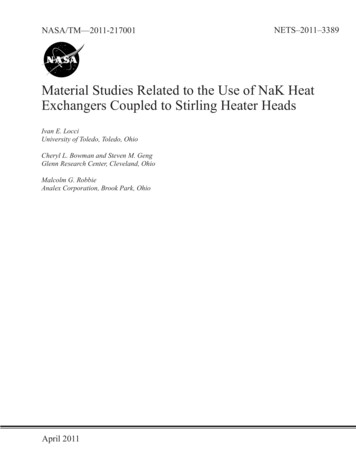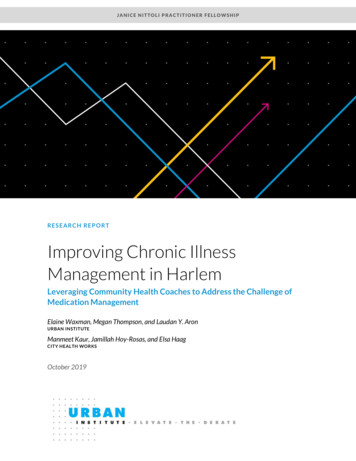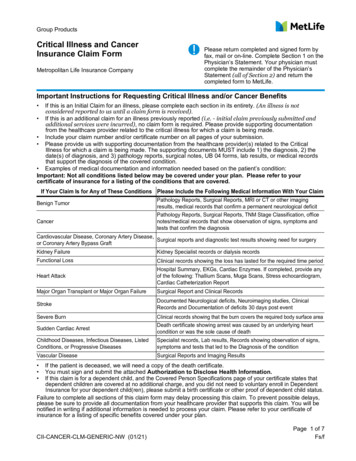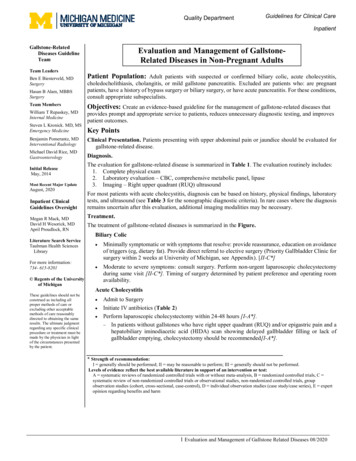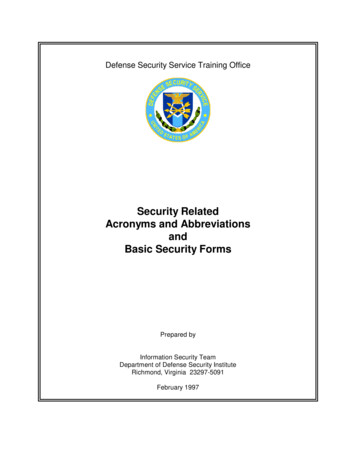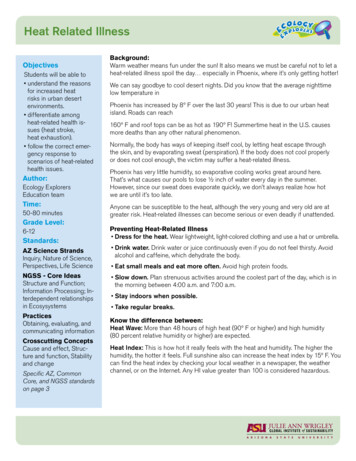
Transcription
Heat Related IllnessObjectivesStudents will be able to understand the reasonsfor increased heatrisks in urban desertenvironments. differentiate amongheat-related health issues (heat stroke,heat exhaustion). follow the correct emergency response toscenarios of heat-relatedhealth issues.Author:Ecology ExplorersEducation teamTime:50-80 minutesGrade Level:6-12Standards:Background:Warm weather means fun under the sun! It also means we must be careful not to let aheat-related illness spoil the day especially in Phoenix, where it’s only getting hotter!We can say goodbye to cool desert nights. Did you know that the average nighttimelow temperature inPhoenix has increased by 8º F over the last 30 years! This is due to our urban heatisland. Roads can reach160º F and roof tops can be as hot as 190º F! Summertime heat in the U.S. causesmore deaths than any other natural phenomenon.Normally, the body has ways of keeping itself cool, by letting heat escape throughthe skin, and by evaporating sweat (perspiration). If the body does not cool properlyor does not cool enough, the victim may suffer a heat-related illness.Phoenix has very little humidity, so evaporative cooling works great around here.That’s what causes our pools to lose ½ inch of water every day in the summer.However, since our sweat does evaporate quickly, we don’t always realize how hotwe are until it’s too late.Anyone can be susceptible to the heat, although the very young and very old are atgreater risk. Heat-related illnesses can become serious or even deadly if unattended.Preventing Heat-Related Illness Dress for the heat. Wear lightweight, light-colored clothing and use a hat or umbrella.AZ Science StrandsInquiry, Nature of Science,Perspectives, Life Science Drink water. Drink water or juice continuously even if you do not feel thirsty. Avoidalcohol and caffeine, which dehydrate the body.NGSS - Core IdeasStructure and Function;Information Processing; Interdependent relationshipsin Ecosysystems Slow down. Plan strenuous activities around the coolest part of the day, which is inthe morning between 4:00 a.m. and 7:00 a.m.PracticesObtaining, evaluating, andcommunicating informationCrosscutting ConceptsCause and effect, Structure and function, Stabilityand changeSpecific AZ, CommonCore, and NGSS standardson page 3 Eat small meals and eat more often. Avoid high protein foods. Stay indoors when possible. Take regular breaks.Know the difference between:Heat Wave: More than 48 hours of high heat (90º F or higher) and high humidity(80 percent relative humidity or higher) are expected.Heat Index: This is how hot it really feels with the heat and humidity. The higher thehumidity, the hotter it feels. Full sunshine also can increase the heat index by 15º F. Youcan find the heat index by checking your local weather in a newspaper, the weatherchannel, or on the Internet. Any HI value greater than 100 is considered hazardous.
Vocabulary:heat index - how hot it really feels with the heat andhumidityheat illness - is a spectrum of disorders due to environmental heat exposure.urban heat island - A metropolitan area which is significantly warmer than its surrounding rural areas. A nighttime phenomenon of increased temperatures in the Phoenix Metropolitan area.evaporative cooling - the process by which evaporationcauses coolingillness directly address the symptoms?Explanation: Peer Teaching (10 min)6) After completing their individual research, the twomembers of each expert team will compare notes andmake sure they both understand the medical condition.7) Once each expert team is confident in their understanding, have each expert team take turns teachingtheir home teams about heat cramps/exhaustion andheat stroke.Advanced Preparation:Prepare various stations around the room with differentheat illness scenarios provided ( sson plans/4a heat illness scenarios.pdf ). Scenarios will describe a situationof either heat cramps/exhaustion or heat stroke. Studentswill need to be able to read the scenario and decidewhether the case involves heat cramps, heat exhaustionof heat stroke.Expansion: Evaluate Heat Illness Scenarios (20 min)Materials: clipboards10) Share the answers with the student teams heat cramps and heat exhaustion expert information heat stroke expert Information heat illness scenarios student worksheets and answer keyRecommended Procedure:Engagement: The Story of Korey Stringer (10 min)8) Separate the groups of four into pairs (one heat strokeexpert and one heat cramp/exhaustion expert).9) Students will proceed through the various stationsaround the room. They will read each scenario and decide if the case involves heat cramps, heat exhaustionor heat stroke, then determine an appropriate course ofactions that will help the situation.Evaluation: Journal Prompt (15 min) :11) Read students the short paragraph about heat illnessand student athletes.12) Have the students write some procedures for helpingstudent athletes prevent heat-related illnesses atarea schools.13) Share some student ideas on the whiteboard.1) Read the brief statement about the death of footballplayer Korey Stringer.14) Then read Dr. Mueller’s recommendationsand discuss.2) Ask the students what happened to him. Write theirresponses on the white board. Ask if the studentshave heard of “heat stroke” or “heat exhaustion”?Extensions:Students can keep a written and/or photo journal of theirexperiences coping with heat in various environmentsduring their daily routines. They may brainstorm ways toimprove their environment with regard to heat risks.Exploration: Heat Illness Jigsaw (15 min)3) Form groups of four. (These are the home teams).Explain that students will become an expert on eitherheat cramps/exhaustion or heat stroke. (These are theexpert teams)4) Assign two students from each home team to readand take notes on the information sheet describing“heat stroke” and the other two students the information describing “heat cramps/exhaustion”.5) Pass out expert information sheets and give guidingquestions, such as: How do the treatments for yourCentral Arizona-Phoenix Long-Term Ecological Research ProjectStudents may interview family members, neighbors andfriends to assess their experiences coping with heat,which can lead to analysis and comparison of interviewdata and discussions about possible solutions to mitigateurban heat island and climate change.As a culmination, students may prepare an exhibit of theirwork. (See the Photovoice lesson in this unit)Related ReadingHave students read the ASU Chain Reaction magazine
article “Thermoregulation: Hot Enough for You?” t2 p30 32.pdf. Have students discuss the article in small groups. Arehumans “warm-blooded” (endothermic) or “cold-blooded”(ectothermic)? Which parts of our bodies are good conductors? Which are good insulators?Common Core/ELA LiteracyRST1: Understand explicit textRST2: Summarize key pointsSL1: Participate in collaborations and conversationsSL2: Integrate oral informationHave the students read the ASU Chain Reaction Magazine article “How Heat Hurts” ct7 master.pdf)Using vocabulary from the articles, ask students to describe the normal healthy process in which heat from thesun hits their bodies and their body responds to maintainits stable temperature. (This provides an opportunity todemonstrate understanding of thermoregulation, radiation,energy, conduction, heat capacity, conductors, insulators,convection, perspiration etc.).Standards:Arizona 7-PO3S3-C1-GRHS-PO1, PO2, PO4S3-C2 GR6-8-PO1,PO2S4-C3-GR7-PO5S4-C3-GRHS-PO2S4-C4-GR8- PO1, PO2S4-C4-GRHS-PO2Arizona Social StudiesS4-C5-GR7-8-PO3-7S4-C5-GRHS-PO3-4NGSS Core IdeasLS1.A: Structure and functionLS1.D: Information ProcessingLS2.A: Interdependent relationships in ecosystemsNGSS PracticesConstructing ExplanationsObtaining, evaluating, and communicating informationNGSS Crosscutting ConceptsCause and effect: Mechanism and explanationStructure and functionStability and changeReferences:1) The American National Red Cross. l2) Arizona Department of Health Services http://www.azdhs.gov/phs/oeh/protect from heat.htmCentral Arizona-Phoenix Long-Term Ecological Research Project
Student WorksheetHeat Related Illness p. 1Heat Cramps and Heat Exhaustion ExpertsHeat illness occurs in stages: heat cramps, heat exhaustion, then heat stroke. Heat stroke is the most severe and caninclude some symptoms of the other stages.You will become an expert in understanding heat cramps and heat exhaustion and then you will teach it to your classmates who are becoming experts in heat stroke. To help other students understand, feel free to act out the symptomsor give examples of what a person with heat exhaustion might look like. Read the following carefully:The first stage of heat illness is Heat CrampsWhat is it? The loss of water and salt from sweating causes the cramps.Symptoms:Muscular pains and spasms due to heavy exertion. They’re usually in the stomach muscles or legs. They can be quitepainful.What should you do? Stop activity and rest. If the person is fully awake and alert, have him or her drink small amounts of cool water or a commercial sports drink. Gently stretch the cramped muscle and hold the stretch for about 20 seconds, then gently massage the muscle. Repeat these steps if necessary. If the victim hasno other signs of heat-related illness, the person may resume activity after the cramps stop.The next stage of heat illness is Heat ExhaustionWhat is it? Heat exhaustion is less dangerous than heat stroke. It typically occurs when people exercise heavilyor work in a warm, humid place where body fluids are lost through heavy sweating. Fluid loss causes blood flow todecrease in the vital organs (like the brain). With heat exhaustion, sweat does not evaporate as it should, possibly because of high humidity or too many layers of clothing. As a result, the body is not cooled properly.Symptoms:Cool, moist, pale, flushed or red skin; heavy sweating; headache; nausea or vomiting; dizziness; and exhaustion. Bodytemperature will be near normal.What should you do? Get to a cooler place and rest in a comfortable position. If the person is fully awake and alert, sip a half glass of cool water every 15 minutes. No alcohol or caffeine as theycan make conditions worse. Remove or loosen clothing and apply cool, wet towelsor sheets. Call 9-1-1 if the person refuses water, vomits or loses consciousness.Central Arizona-Phoenix Long-Term Ecological Research Project
Student WorksheetHeat Related Illness p. 2Heat Stroke ExpertsHeat illness occurs in stages: heat cramps, heat exhaustion, then heat stroke. Heat stroke is the most severe and caninclude some symptoms of the other stages.You will become an expert in understanding heat stroke and then you will teach it to your classmates who are becoming experts in heat cramps and heat exhaustion. To help other students understand, feel free to act out the symptomsor give examples of what a person with heat stroke might look like. Read the following carefully:What is it?Also known as sunstroke, heat stroke is life-threatening. The victim’s temperature control system, which producessweating to cool the body, stops working. The body temperature can rise so high that brain damage and death mayresult if the body is not cooled quickly.Symptoms: Vomiting Decreased alertness level or complete lossof consciousness High body temperature (above 104º F) Skin may still be moist from sweating or the person may stop sweating and the skin may be red, hot and dry Rapid, weak pulse Rapid, shallow breathingWhat should you do?Heat stroke is a life-threatening situation! Help isneeded fast. Call 9-1-1. Move the person to a cooler place. Quickly cool the body. Wrap wet sheets around the body and fan it. If you have ice packs or cold packs, wrap themin a cloth and place them on each of the victim’s wrists and ankles, in the armpits and on the neck to cool the largeblood vessels. (Do not use rubbing alcohol because it closes the skin’s pores and prevents heat loss.) Watch for signs of breathing problems and make sure the airway is clear. Keep the person lying down.Central Arizona-Phoenix Long-Term Ecological Research Project
Student WorksheetHeat Related Illness p. 3Diagnose each scenario in the spaces below.What treatment should you give?Look at the treatment sheet for a list of possibility, then circle all the letters that apply.Soccer Game: Diagnosis:Treatment: ABCDEFGHIJKLVisiting Grandma: Diagnosis:Treatment: ABCDEFGHIJKLTrip to the Beach: Diagnosis:Treatment: ABCDEFGHIJKLSummer Job: Diagnosis:Treatment: ABCDEFGHIJKLGood Samaritan: Diagnosis:Treatment: ABCDEFGHIJKLGrand Canyon: Diagnosis:Treatment: ABCDEFGHIJKLSchool Dance: Diagnosis:Treatment: ABCDEFGHIJKLBonusPoor Perro!: Diagnosis:Treatment:Central Arizona-Phoenix Long-Term Ecological Research Project
Student WorksheetHeat Related Illness p. 4Engagement: The Story of Korey StringerHave you ever heard of Korey Stringer? He was an offensive tackle for the Minnesota Vikings. On August 1, 2001 hereported to the Vikings training camp. He was 27 years old, 6-foot-4-inches, 335 pounds and starting his 7th season.He could not complete the first practice in the morning and was carted off the field. He did not practice Monday afternoonbut vowed to return on Tuesday. He participated in the Tuesday morning practice session which lasted two and a halfhours. The players were all in full pads.The temperature on the practice field was around 90 degrees with high humidity. The combination of humidity and temperatures made it feel like 110 degrees. Stringer vomited three times during practice and then walked to an air-conditionedshelter. There he became dizzy and weak and began breathing heavily.Stringer was driven by ambulance to Immanuel St. Joseph’s-Mayo Health System, where his body temperature was 108degrees upon arrival. He was unconscious until he died at 1:50 a.m.What happened to Korey Stringer?Wrap-up activity: Heat Illness andStudent AthletesAccording to the Centers for Disease Control and Prevention, three hundred Americans, die of heatstroke every year, mostof them elderly or infants. There have been over 20 heatstroke deaths of high school and college football players since1995.What are some procedures you think might help student athletes prevent heat-related illnesses at school?Central Arizona-Phoenix Long-Term Ecological Research Project
Student WorksheetHeat Related Illness p. 5ABCPlace ice packs on wrists,ankles, armpits, and neck.Call 911.Cool body by wetting skinand blowing fan, or applywet sheets.DEFRemove excess clothing.Resume normal activity.Lie down and make sure he/she doesn’t choke if theyfaint.GHIStretch sore muscles andhold for 20 sec., then massage. Repeat if needed.Move to a cooler place.Check to see if he/she isalert and awake.JKLTake it easy for several days.Drink ½ glass of water orsports drinkevery 15 min.Seek medical attention!Central Arizona-Phoenix Long-Term Ecological Research Project
Student WorksheetHeat Related Illness - Answer KeyDiagnose each scenario in the spaces below.What treatment should you give? Look on attachedsheet for a list of possible treatments, then circle all theletters that apply.Soccer Game: Diagnosis —heat muscle cramps-firstsign of heat illnessTreatment: KGEVisiting Grandma: Diagnosis—heat exhaustionTreatment: HFKDCLTrip to the Beach: Diagnosis—heat strokeTreatment: BHCAFLSummer Job: Diagnosis—heat strokeTreatment: BHCAFLGood Samaritan: Diagnosis—heat strokeTreatment: BHCAFLGrand Canyon: Diagnosis—heat exhaustionTreatment: HFKDCSchool Dance: Diagnosis—heat exhaustionTreatment: HFKDCCentral Arizona-Phoenix Long-Term Ecological Research ProjectBonusPoor Perro!: Diagnosis—Heat strokeTreatment: Immediately cool the dog’s body with a hoserunning the water over his mouth and tongue, belly andbetween his legs making sure the skin is wet and not justrunning off the hair. Make sure air is moving across it toallow evaporative cooling. Make sure you stop coolingwhen the body reaches 103º F as the body will continueto cool down. Smaller dogs will cool down more quickly.Then, head to the nearest animal hospital for possible IV’sand medication to stop cell damage. Dogs with shorterfaces, like boxers, overheat more quickly as do older oroverweight dogs. All dogs overheat faster than people do,because they rely on panting to cool off which is moreinefficient than sweating.Dr. Mueller’s Suggestions for Student Athletes:Dr. Fred Mueller, a director of sports medicine at theUniversity of North Carolina, has sorted through databack to 1931 to study heatstroke deaths in high schooland college football.“When you have high heat and high humidityand a football team with all of that equipmentcovering the body, the chances of heatstrokeare more likely in this sport than in others,”Mueller said. “Out of this death (of KoreyStringer) the N.F.L. might want to look at threethings: 1) change the time of practices or makethem shorter when there is high heat and humidity; 2) enforce water breaks, not just makethem available; and 3) make sure your playersare climatized to the area before practices inpads, allowing a 7-to-10-day period to adjust toweather before full-bore, full-padded practices.”
14) Then read Dr. Mueller’s recommendations and discuss. Extensions: Students can keep a written and/or photo journal of their experiences coping with heat in various environments during their daily routines. They may brainstorm ways to improve their environment with regard to heat ri

